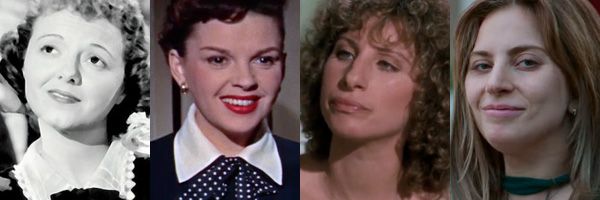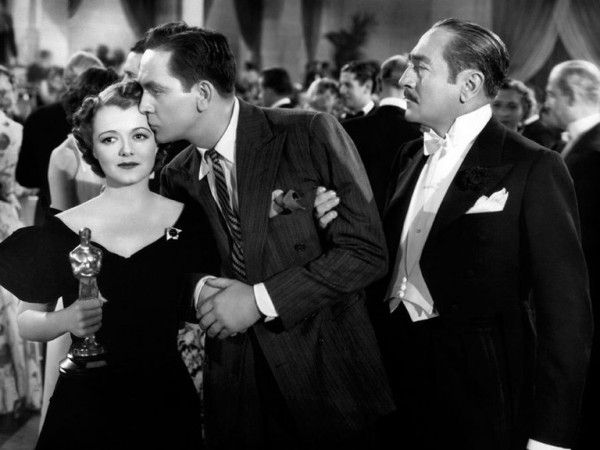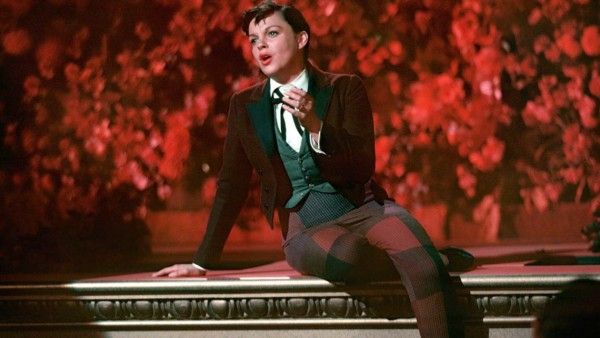Bradley Cooper’s new adaptation of A Star Is Born is now in theaters, and while it feels fresh and new, the film also hews to the same plot beats of previous movies. Cooper’s film is the fourth version of A Star Is Born. The story originally came to the big screen in William A. Wellman’s 1937 movie, which starred Janet Gaynor and Fredric March. The first remake came along in 1954, directed by George Cukor and starring Judy Garland and James Mason. Give it another twenty years or so, and you’ve got another adaptation, this time in 1976 with Frank Pierson directing and Barbra Streisand and Kris Kristofferson in the lead roles. Finally, with today’s version, you’ve got Cooper directing and starring opposite Lady Gaga.
Although the story spans different eras and even different industries, the overall plot remains remarkably similar throughout all four versions. [Spoilers ahead for all versions A Star Is Born] The story always begins with the male lead as a star on the decline due to alcoholism. The male lead then always discovers the female lead, who has the talent, but hasn’t broken through to stardom. The two strike up a relationship where his connections in the industry help provide her with a path to stardom. They eventually get married even though he continues to decline. His addiction gets worse while she becomes a total star and wins an award. At the award ceremony, he drunkenly humiliates her as she wins an award, thus merging her triumph and tragedy. She vows to stay with him and help him through his addiction, but just as it looks like he might recover, he stumbles again and realizes he’ll never be more than a washed-up drag on her career. He commits suicide, and she mourns his death. Her career now stands as a tribute of sorts to the man she loved.
But it’s where these versions diverge that gives them their own personality and distinction.
A Star Is Born (1937)
This one stands mostly as the template for the others, and yet it doesn’t have much of a personality of its own. It starts out promisingly enough by following the female lead Esther Victoria Blodgett (Gaynor) as she makes her way to Hollywood and then later introduces actor Norman Maine (March) when she meets him while working as a waitress at a Hollywood party, but you never really buy the love story between the two characters. It’s there in the plot beats, but there’s nothing electric or dangerous or unique about their love story. It’s perfunctory, and while it has a tragic element, the story only works in the broad strokes of “A star is born, so a star must die,” seeing stardom as a zero-sum game where there are only so many seats at the table.
The one aspect where Wellman’s movie seems to work is with an almost cynical take on Hollywood, avoiding the trappings of the love story and instead showing the hollowness of the Hollywood machine at work by showing the bitter machinery of publicity all the way to opening and closing with script pages describing the first and last shot of the movie. And yet this sets the movie at war with itself where Esther, who is later redubbed Vicki Lester by the studio, has both an emotional arc and yet is also just a pawn in a studio machine. You leave the movie feeling that Vicki is going to be chewed up and spit out just as Norman was, and rather than a tragic love story, you have a fatalistic tale about Hollywood.
A Star Is Born (1954)
The biggest strike against the 1954 version is its epic runtime. The studio originally demanded that Cukor cut down the movie from its original 181-minute length and removed 30 minutes over his objections. In 1983, all but 5 minutes were “restored”, although I use that term very loosely as some of the restoration is just dialogue over production stills rather than scenes that were filmed and reinserted. This leads to a movie that not only feels bloated, but also janky with things that seem like directorial choices instead being nothing more than a patch job. Not everything in this movie had to be put back in, and it slows the pace considerably.
Somewhere in the three-hour cut of A Star Is Born is a good two-hour movie because it makes Vicki and Norman feel like equal parts of the same story. In this version we lead with Norman on the decline, and while drunk, he meets Esther/Vicki at a performance, but the way the story evolves you feel like you're getting both sides of it. There’s also much more care placed on the nuances of fame and industry pressure. In the 1937 original, these factors felt like cold inevitabilities, but here they’re dealt with in an emotional manner that lets you feel the triumphs and tragedies in the romance. It also helps that Garland and Mason are both terrific with neither shying from the darkness or pain in their respective roles. However, the conclusion of the movie leaves a sour taste as it feels like Lester’s life now is part of a monument to Maine rather than a woman who had the talent to become a star.
A Star Is Born (1976)
This is the worst version of A Star Is Born. Although it makes the crucial change of moving the action from actors in Hollywood to the music scene, the story overall just serves Streisand’s ego. There may as well not be a male lead in this story, and although Kristofferson gives a serviceable performance, this is really the story of Esther Hoffman, who meets while looking for a drink at a bar. And because it’s all about Esther, it fails entirely as a romance because there’s zero chemistry between Esther, and Kristofferson’s character, fading musician John Norman Howard. While there’s not much romance in the 1937 original, it at least goes through the motions where you believe that the two characters at least care about each other. Here, John is a stepping stone for Esther’s story.
And perhaps that story would at least be somewhat tolerable if Esther was in any way endearing, but there’s not much to like about her personality or her music. I like that Streisand is going for a “take-no-nonsense” approach, but there’s no texture to her character, so Esther just always seems annoyed with everyone as if they’re getting in the way of her dreams. Unfortunately, her dreams don’t really seem worth pursuing since her music is awful. Streisand is a hell of a singer, but the music here is instantly forgettable. I suffer from songs constantly getting stuck in my head, and I can’t remember a single melody from this movie, which is a problem when your movie is about someone who is an amazing musician.
A Star Is Born (2018)
Bradley Cooper’s movie feels like it learns from the mistakes of its predecessors. Both leads, Ally (Gaga) and Jackson Maine (Cooper), are treated as equal partners in the story rather than one getting out in front of the other, and their love story has texture and nuance because it’s rooted in their love of music, and specifically crafting that music. Like the 1976 version, Maine meets the female lead while at a bar looking for a drink, but Cooper is always honing in on the specificity of every moment and every interactions. While fame is seen as an external force, Cooper tells his story from the inside out, focusing on the inner lives of his characters and seeing how that drives them both as individuals and as a couple.
The movie also speeds past the 1976 version by having music that’s outstanding. I’ve had “Shallow” stuck in my head for about a month, and I don’t expect to shake it anytime soon. But rather than just churning out at Top 40 hit, the music still comes back to expressing the personalities and lives of its lead characters, which makes this A Star Is Born feel like a richer experience.
It’s also important to note that this movie is built on the ones that came before, and that to simply label it as “best” would be to miss out on not only what the others contributed, but the era in which they were made. If the Judy Garland version had been made today, then Esther would probably be a stronger, more independent woman than the 1954 version allows her to be. These movies are a product of the times they were made, both for good and for ill, and while Cooper’s version is not without its flaws, it feels like the best realized version of this story.





